- Java Spring vs Node JS
- Advanced Node.JS Interview Questions
- Node.JS Interview Questions And Answers
- Lost in translation - Node.JS
- Basic Examples of Node.js
- In the right place at the right time - Node.JS
- Introduction to Node.js
- Next JS Interview Questions
- Node Js vs Golang
- Node.Js Projects and Use Cases
- How to Install Node.js?
Middleware is the layer that exists between the application components, tools, and devices. With middleware, you can simplify connectivity between the components. Node.JS middleware plays a prime role in the request-response lifecycle of Node.JS execution.
There are many types of node.JS middleware, such as application-level, router-level, built-in, error-handling, and third-party middleware.
This blog will go over the middleware in Node.JS, its importance, types, creating middleware, and many more.
| Middleware in Node.JS - Table of Contents |
What is Middleware in Node.JS?
Middleware is nothing but a function that has access to response objects, request objects, and the next middleware function. It exists in between the request and response cycles of Node.JS execution. Generally, the request object is referred to by the variable ‘req', whereas the response object is referred to by the variable ‘res’. Note that middleware can process ‘req’ objects before the server sends a response.

With middleware Node.JS, we can do a multitude of things. To begin with, we can run any codes with middleware functions. Also, we can make changes in response and request objects. We can end the request and response cycle in Node.JS execution. Further, we can call the next middleware function in the queue for Node.JS execution.
| Get ahead in your career by learning Node.js through MindMajix Node.js Training. |
What is Middleware?
Middleware is nothing but software that exists between operating systems and applications. Middleware connects data, users, and applications. That’s why we use middleware to manage data and communication.
Middleware acts as the bridge between applications, tools, and devices, including databases. In other words, middleware simplifies connectivity between applications, back-end data sources, and application components. Thus, it accelerates the development of distributed applications.
Middleware eases connectivity, supports secured connections and data transfer, and manages traffic across distributed systems. With middleware, you don’t need to make custom integrations every time.
Know that there are many types of middleware, such as message-oriented middleware, RPC middleware, database middleware, ORB middleware, and so on.
Why Middleware?
Do you want to know why middleware plays a prime role in data management and communication? Here are the reasons:
- Middleware simplifies software development
- It controls connections between application components
- No doubt, it is a cost-effective tool for managing multi-cloud resources.
- It plays a crucial role in load balancing, concurrent processing, and transaction management.
- With middleware, you can make secured access to back-end resources such as storage, databases, etc.
- It supports authentication functionalities on a greater scale
- You can enhance rendering performance for client-side significantly
- By using middleware, you can easily set HTTP headers

What is Node.JS?
Node.JS is an open-source as well as JavaScript runtime environment. As it supports cross-platform, you can run Node.JS anywhere, whether it is Windows, Linux, or macOS. Node.JS is a platform that runs on the JavaScript engine.
By using Node.JS, you can build dynamic page content. Also, you can open, close, read, write, modify, create and delete files on the server.
Know that all APIs of Node.JS are asynchronous. In other words, they are non-blocking APIs. Node.JS is an asynchronous event-driven runtime environment with which you can develop scalable network applications.
Node.JS uses a single-threaded model, but at the same time, they are highly scalable. What’s more! They don't buffer any data, but they release data in chunks.
| Related Article: What is Node.JS |
What is the Next ( ) Function?
The next ( ) function plays a vital role in applications' request and response cycle. It is a middleware function that runs the next middleware function once it is invoked. In other words, the Next function is invoked if the current middleware function doesn’t end the request and response cycle. It is essential to note that no middleware function should be hanging in the queue.

The image below is the middleware function where you can find its different components.
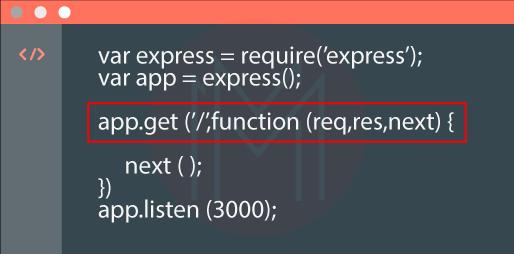
Let’s look at the description of the components one by one in detail.
get: It refers to the HTTP method
function: It is the middleware function
req: It refers to the HTTP request argument
res: It refers to the HTTP response argument
next: It refers to the callback argument
What is Express Middleware?
It is nothing but a routing as well as a middleware framework with which you can handle different routing of web pages. It works in-between request and response cycles. It can handle any error since it comes with default error-handling middleware functions. They are the functions compiled while making requests to the express server.
Every HTTPS request, as well as the response, can be easily accessed by the middleware. Even the middleware can terminate HTTPS requests independently. Or, it can transfer the request to another middleware function using the next function.
With the help of express middleware, you can build mobile as well as web applications. So, you can build single-page, hybrid, and multipage web applications seamlessly.
The syntax for the express.js middleware function is given as follows:

Types of Node.JS Middleware
There are five types of middleware as follows
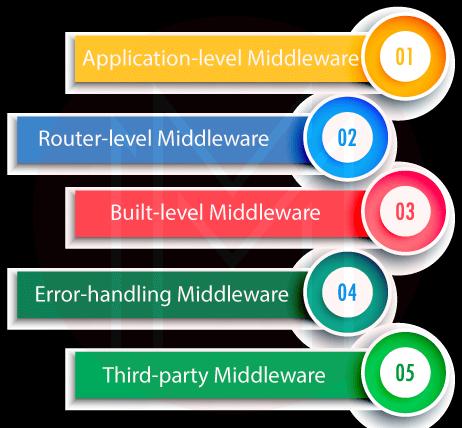
Application-level Middleware
Know that every GET and POST call needs authentication. So, if you need to authenticate GET and POST calls, you can develop authentication middleware. This is because application-level middleware focuses on authenticating users. Once the authentication request is received, the authentication middleware invokes authentication code logic.
If the authentication is successful, the rest of the route is progressed with the help of the next function. On the other hand, if the authentication is unsuccessful, there is no progress in the route, and the middleware releases error messages.
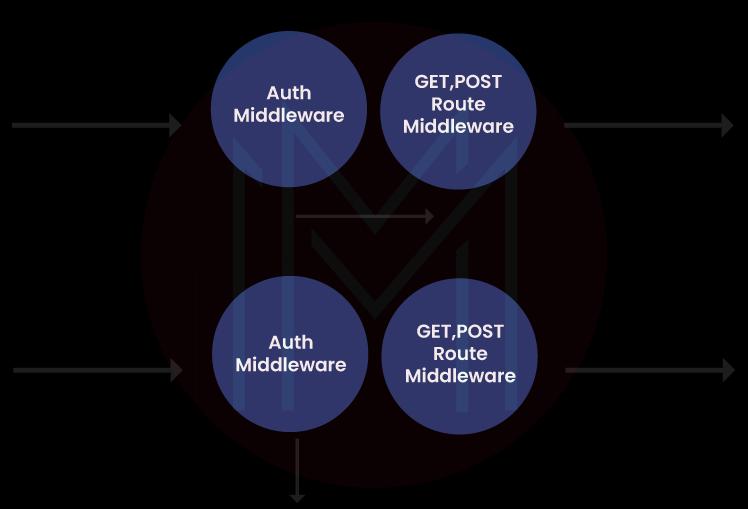
Router-level Middleware
This middleware works in the same way application-level middleware works. By using the express. router ( ) function, this middleware supports creating and managing instances. Moreover, you can load router-level middleware with the help of the router.use ( ) function as well as router.METHOD ( ) function.
Built-in Middleware
There are three built-in middleware functions. Know what they are from below:
- Static: They are functions that act as static assets to applications. HTML files and images are a few examples of static assets.
- JSON: This function processes incoming requests along with the JSON payloads.
- Express.URL-encoded: This function processes incoming requests along with URL-encoded payloads.
Error-Handling Middleware
Express.JS has default error-handling middleware functions. That's why it can handle any error.
The functions have four arguments instead of three. You can understand this from the below code.
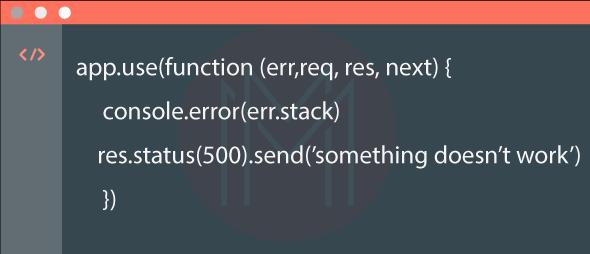
Third-party Middleware
This middleware resolves the need for additional features required for back-end operations. First, you must install Node.JS modules for specific functions and implement the same in applications on the route or application level.
How to create Node.JS Middleware?
First of all, we must install Node.JS software before creating middleware. Additionally, we must install Express.JS to create Node.JS middleware successfully.
You can follow the below steps for creating Node.JS middleware.
Initialising
Generally, middleware has the following signature function
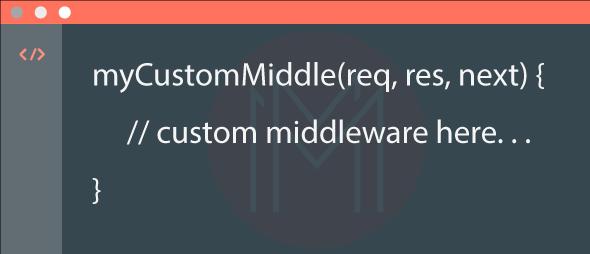
As you know, ‘Req’ is the request object, whereas ‘Res’ is the response object. And the next function is used to run the next middleware function in the request-response lifecycle. With middleware, you can modify Req and Res objects and many mor
Modifying the Req object
This step is needed to authenticate the current user who has logged in. Then, you must write middleware for this case. After writing the middleware to authenticate the user, we can add the middleware to the application. As a result, the middleware is seamlessly activated in all the application routes
Modifying the Res object
You can set a custom header in response objects using the Res object.
Ending the request-response cycle
In the end, you need to check whether the user object is added to the request object. If you cannot get the desired result or authenticate the user, it is better to end the request-response cycle.
| Related Article: Node.JS Interview Questions And Answers |
Advantages of Node.JS Middleware
There are many advantages to using Node.JS middleware for data management and communication.
Let’s take a look at them below
- We can understand the type of request enabled by the client.
- We can easily connect with databases, including MongoDB and MySQL.
- It allows easy processing of static files such as HTML, images, etc.
- It allows managing multiple GET requests on a single web page.
Conclusion
In short, Node.JS middleware simplifies data management through the request-response lifecycle. We can run any codes with this middleware and seamlessly manage the request and response objects. Also, we can terminate the request-response lifecycle and invoke the next function for executing the next middleware function. Overall, Node.JS middleware improves the connectivity between application components, devices, and databases.
 On-Job Support Service
On-Job Support Service
Online Work Support for your on-job roles.

Our work-support plans provide precise options as per your project tasks. Whether you are a newbie or an experienced professional seeking assistance in completing project tasks, we are here with the following plans to meet your custom needs:
- Pay Per Hour
- Pay Per Week
- Monthly
| Name | Dates | |
|---|---|---|
| Node.JS Training | Dec 27 to Jan 11 | View Details |
| Node.JS Training | Dec 30 to Jan 14 | View Details |
| Node.JS Training | Jan 03 to Jan 18 | View Details |
| Node.JS Training | Jan 06 to Jan 21 | View Details |

Madhuri is a Senior Content Creator at MindMajix. She has written about a range of different topics on various technologies, which include, Splunk, Tensorflow, Selenium, and CEH. She spends most of her time researching on technology, and startups. Connect with her via LinkedIn and Twitter .















